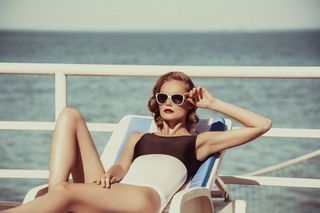
Your Summer 'Base Tan' Is Wrecking Your Skin

Is it safe to get a "base tan" in the summer?
No. There is no safe amount of tanning.
Tanning isn't bad for you just because it comes with the risk of burning, which can cause skin cancer. Tanning is bad for you because your body doesn't even begin to tan until dangerous ultraviolet (UV) rays have pierced your skin and started to mess with your DNA.
And that alone significantly increases the risk of skin cancer, said Dr. Roxana Daneshjou, a dermatology resident at the Stanford University School of Medicine. [5 Things You Must Know About Skin Cancer]
"There's really no such thing as safe tanning, other than … putting a fake color on your skin," Daneshjou told Live Science. "Fairer-skinned people may not even tan until they burn."
And while burning represents a more significant danger — because it means that skin cells have become so sun-damaged that they die — the skin damage that begins at the very start of the tanning process is still dangerous, Daneshjou said.
"Some people say, 'Well, I should tan, because that extra melanin will protect me.' But that logic doesn't make sense. You're doing so much damage just to get that little bit of protection," she said.
Sign up for the Live Science daily newsletter now
Get the world’s most fascinating discoveries delivered straight to your inbox.
Melanin is a pigment found in skin cells that's produced when UV rays hit the skin. The more melanin produced, the darker the tan. (And people with more melanin in their skin have darker skin tones.)
It's true that melanin can protect the body to some extent against UV rays — it absorbs UV rays to a point, acting as the skin's natural sunscreen, Daneshjou said. But the process of adding an extra dose of melanin to the skin — in other words, tanning — is actually a defense mechanism that begins only after damage has been done.
Daneshjou also noted that people who tan for aesthetic reasons are hurting themselves in the long run. [7 Beauty Trends That Are Bad for Your Health]
Dermatologists break down the dangerous portion of UV light into two categories: UV-A and UV-B. Both cause the kind of DNA damage that can lead to skin cancer, but UV-A in particular can contribute to a second problem: It breaks down the natural collagen in the skin, which can lead to premature aging.
"Collagen is the support structure for the skin," Daneshjou said. Without the support structure, she said, skin wrinkles, thins and weakens, taking on a papery appearance.
No anti-aging product, even the dermatologist-recommended ones, can slow skin aging as much as simply using sunscreen in the first place, she said.
Daneshjou said that to prevent these kinds of problems, dermatologists recommend everyone (light- or dark-skinned) use sunscreen (broad-spectrum products, or clearly marked as protecting against both UV-A and UV-B) year-round. UV-B exposure increases in the summer and decreases in the winter, but UV-A exposure occurs year-round. And both forms of UV light can pierce clouds and cause damage on cloudy days.
"People say, 'Oh, I don't spend time in the sun,'" Daneshjou said. But such people should still wear sunscreen. UV light pierces car windshields, and can cause damage over the course of even short walks outside.
Daneshjou said people should apply about a shot-glass worth of sunscreen to their bodies when wearing a typical summer outfit.
Originally published on Live Science.

Most Popular



